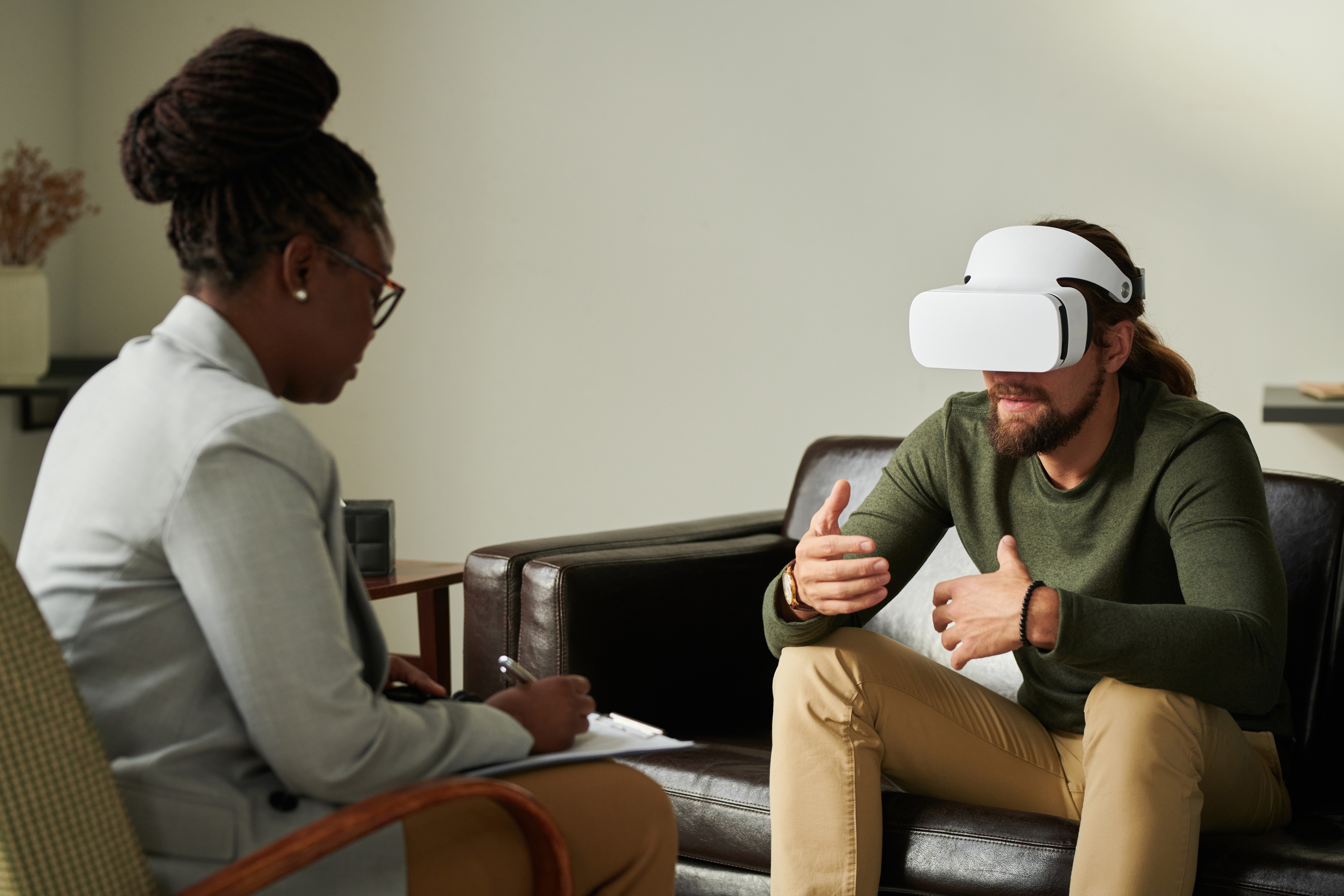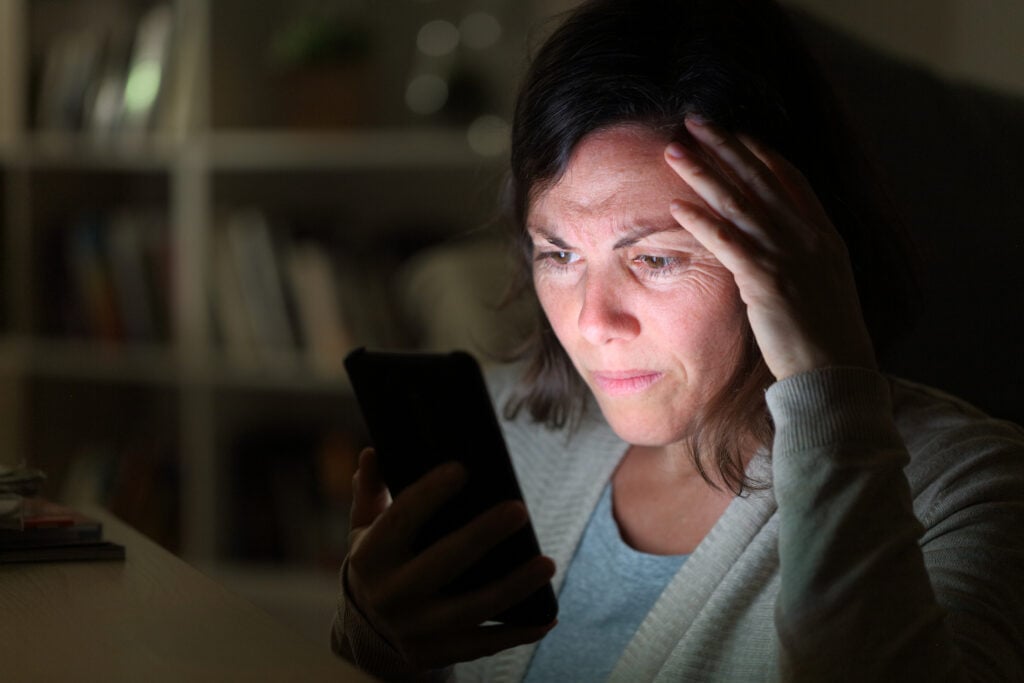How VR therapy can help you face your fears
Reviewed by Susan Radzilowski, MSW, LMSW, ACSW


Imagine you’re scared of heights, but you find yourself standing on the open-air observation deck of the Empire State Building on a crisp autumn morning. As you walk to the edge and look down 1,250 feet onto the streets of Manhattan, your heart speeds up and you can’t quite catch your breath.


Suddenly your therapist is right there with you, guiding you through your anxiety. In the next moment, they press a button—and you’re safely back in their office, where you’ve been all along.
You’ve just experienced virtual reality exposure therapy (VRET), a type of therapy that’s showing great promise in treating phobias, anxiety, and other mental health concerns. Once out of reach for many patients financially, VRET is becoming more accessible thanks to smartphone apps and less expensive commercial headsets.
In exposure therapy, you’re exposed to an object, situation, place, or memory that distresses you. The expectation is that your reaction will be intense on first exposure and lessen as that exposure is repeated, until you can comfortably face your fear.
According to psychologist Elizabeth McMahon, PhD, who specializes in VRET, “The goal is for you to be able to, in real life, face what has scared you.”
Welcome to the future of mental health care
Technology has seeped into every aspect of our lives. From dating to parenting to ordering dinner, chances are you rely on some form of it to get through the day.
The world of mental health is no exception, despite being rooted in real-life human connections. It seems like each week brings news of groundbreaking solutions and high-profile failures from companies that want to modernize the age-old practice of therapy.
As we approach the new year, therapist.com will explore the future of digital mental health. What’s next for therapy, now that tech has truly entered the room? We’re curious if the technologies adopted by practitioners in recent years—including virtual reality, artificial intelligence, and teletherapy—are fulfilling their promise to increase access to mental health care. Just as important: How effective are these tools for therapy patients? We’ll also consider the underlying ethical challenges that come along with our new digital landscape.
First off, a technology that’s been around for a while but keeps evolving in compelling ways: virtual reality.
How virtual reality works in a therapeutic setting
Starting in the late 20th century, psychologists began to use VR headsets to create exposure environments for patients in the comfort and safety of a therapeutic space.1 Here’s how it works.
In an office setting, your clinician will likely provide a VR headset, which can run anywhere from a few hundred to a few thousand dollars. McMahon notes that during the pandemic, many companies pivoted their products to let therapists offer VRET via teletherapy. In that scenario, your therapist connects either to your VR headset or to an app on your smartphone. To use the app for treatment, you’ll just need a headset that’s compatible with your phone—a more affordable option that usually runs under $50.
Once you’ve put on your headset and adjusted to your virtual environment, McMahon says, “I log in to a website to control what displays in the VR, just as if we were using a headset in my office.” Then she begins talking you through a scenario designed for your diagnosis.
If you have a specific phobia or fear, your therapist will gradually increase your exposure to that stimulus. For example, if you suffer from social anxiety, your VR experience may involve walking through larger and larger gatherings.
VRET can help treat most fears and phobias in just a few sessions, McMahon says. But more complex conditions, such as posttraumatic stress disorder (PTSD), may require many more.2
Why VR works so well in exposure therapy
Exposure therapy has some challenges: It can be logistically difficult, patients may be hesitant to face their fears head-on, and clinicians may view it as risky because exposure may be difficult to control. VRET helps address these concerns by providing a professional, controlled environment that mitigates risk.
In the era before VR, says McMahon, therapists often relied on their clients to imagine scenarios to work through. This isn’t always an effective approach. “Some people have a harder time imagining a scenario or immersing themselves in an imagined environment,” says McMahon. In VRET, that environment is provided for the client, and the clinician can regulate it.
For example, if you have a fear of public speaking, McMahon can gradually move you onto a stage and design the audience’s reaction to you. She can also control the number of people, the size of the stage, the lighting, and other angles to help you overcome your fear.
The benefits of a new perspective
In addition to VRET, virtual reality offers a range of other mental health benefits.
VR can help reduce implicit bias. Using immersive virtual reality (IVT), where an artificial environment replaces a user’s real surroundings convincingly enough for them to suspend disbelief, researchers have been able to place people in each other’s shoes.3 In a 2013 study, light-skinned participants were assigned a dark-skinned virtual body and asked to navigate a virtual world from this new perspective. The results showed a decrease in racial bias.4
VR can help you build empathy. “There’s fascinating research about using VR to treat depression and teach self-compassion,” McMahon says. Researchers found that by creating an experience where adult participants consoled a childlike version of themselves through avatars, they felt safe and content, with increased self-compassion and a lower level of self-criticism.5
VR can offer new ways to connect. Social connection is the strongest protective factor against depression.6 Screen-based VR, which includes virtual environments like Second Life, can offer socially anxious or otherwise isolated users new opportunities for community.7 In these immersive worlds, users can choose avatars to represent themselves, hold jobs, build social circles, and even get married and start families.
Donna Davis, PhD, who directs the Oregon Reality Lab and studies screen-based VR, shares one example of a younger woman diagnosed with Parkinson’s disease. The woman had found an in-person support group, but its participants were much older and she had trouble relating. In Second Life, Davis says, “she found a support group where everyone’s avatar was young and healthy. They had a conversation from a completely different emotional space that she couldn’t find in the physical world.”
The downsides of VR
As a culture, we’ve started to grow weary of too much technology, even as our daily lives require more of it. So it’s common to have mixed feelings about VR, and experts acknowledge it does carry some risk.
You can get addicted. Davis is adamant that VR should never be used in lieu of real life. “The danger comes when these technologies are used to replace our physical world,” she says. If you’re neglecting your family, ignoring your responsibilities, or isolating yourself, you may be developing an addiction to screen-based worlds. “At the end of the day, our physical world is the one where we need to survive,” says Davis.
You shouldn’t go it alone. Perhaps the biggest risk in making VR—and especially VRET—more accessible is that people may try using the technology to self-treat without a therapist. “If you go through an experience screaming and terrified,” McMahon says, “you’re going to come out more terrified.” But with professional guidance, you can be fully prepared for exposure, which McMahon says will greatly lower your risk of being retraumatized.
You may have difficulty finding a VR-trained therapist. VR mental health is a growing field, says McMahon, and the number of clinicians trained in using the technology has not kept pace with demand. “I have clients from all over the world calling me for a VR-trained therapist,” she says. The hopeful news is that her workshops on VR have doubled in size in the past few years.
What about VR apps?
There’s been a recent influx of self-care apps that use VR, such as Liminal and Innerworld, and many businesses rely on them to help support employees’ mental health.8 These should be used only as a supplement for therapy, not as a replacement, McMahon says: “In these apps, the VR exposures are preset and will not be tailored to the user. This is important because people with the same phobia can have wildly different fears.”
As a first step, McMahon recommends working with a mental health professional to define your specific fear. Then they can help determine if VR is an appropriate treatment option for you. To find a licensed therapist in your area, browse our directory.
Using virtual reality to improve our real lives
VR’s most important contribution to mental health may be its ability to help us heal by reimagining our perspective. Davis has witnessed this many times in her work: A 64-year-old person who was unable to have children can build a virtual family with six kids. A young trans woman gets to practice interacting as her true self before coming out.
I found one of Davis’s stories especially moving. A woman in her 80s was living in isolation with limited mobility. Her son signed up for Second Life, and together they created avatars. Using VR, this woman could put on a gown and go ballroom dancing with her son, which she thought she’d never do again.
When I think about her twirling around the floor, her movements finally painless and fluid, I feel a deep sense of hope about the kind of healing this technology can bring.

Sources
1 https://www.ncbi.nlm.nih.gov/pmc/articles/PMC5421394/
2 https://www.ncbi.nlm.nih.gov/pmc/articles/PMC2553247/
3 https://www.techtarget.com/whatis/definition/immersive-virtual-reality-immersive-VR
4 https://www.sciencedirect.com/science/article/abs/pii/S1053810013000597
5 https://www.ucl.ac.uk/news/2014/nov/virtual-reality-helps-people-comfort-and-accept-themselves
6 https://ajp.psychiatryonline.org/doi/10.1176/appi.ajp.2020.19111158/
7 https://www.nbcnews.com/id/wbna17538999
8 https://www.theguardian.com/business-to-business/2017/dec/11/virtual-therapy-and-stress-busting-apps-can-tech-support-mental-health-at-work
About the author
Amye Archer, MFA, is the author of “Fat Girl, Skinny” and the coeditor of “If I Don’t Make It, I Love You: Survivors in the Aftermath of School Shootings,” and her work has appeared in Creative Nonfiction magazine, Longreads, Brevity, and more. Her podcast, “Gen X, This Is Why,” reexamines media from the ’70s and ’80s. She holds a Master of Fine Arts in creative nonfiction and lives with her husband, twin daughters, and various pets in Pennsylvania.
Related articles

What is digital self-harm, and why are teens doing it?
In an alarming new trend, teens are posting harmful content about themselves...

Is it healthy to take a break from the news?
If the 24/7 news cycle is affecting your mental health, you’re not alone...

How to cut through the clutter of digital hoarding
In today’s tech-heavy world, it’s easy to let digital files pile up. If...

Can therapy help when it’s not your own?
Podcasts like “Dear Therapists” let millions of listeners experience...
